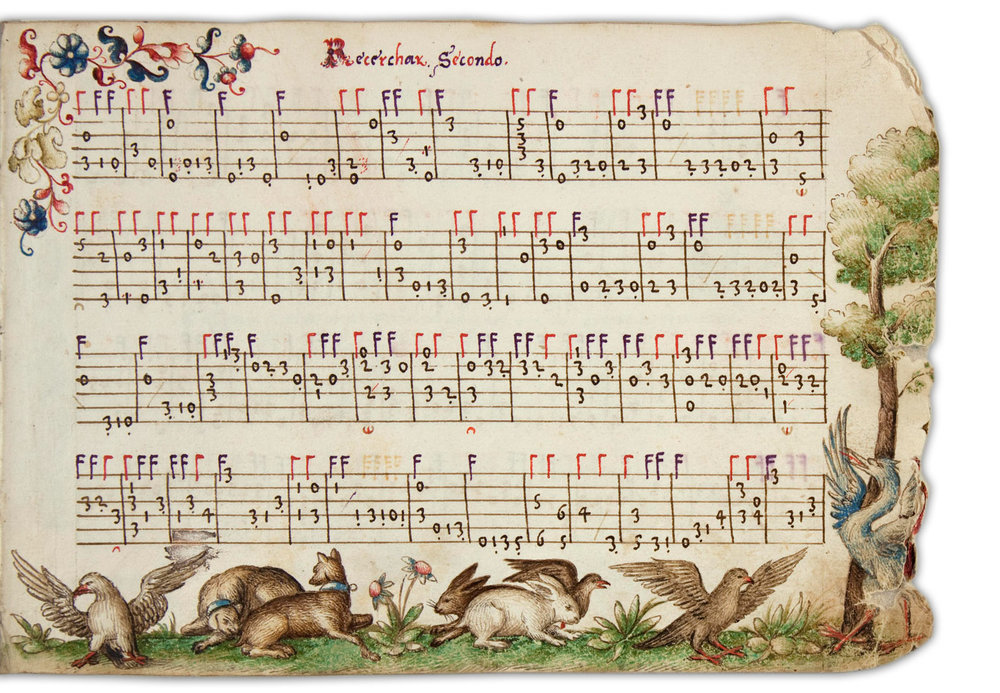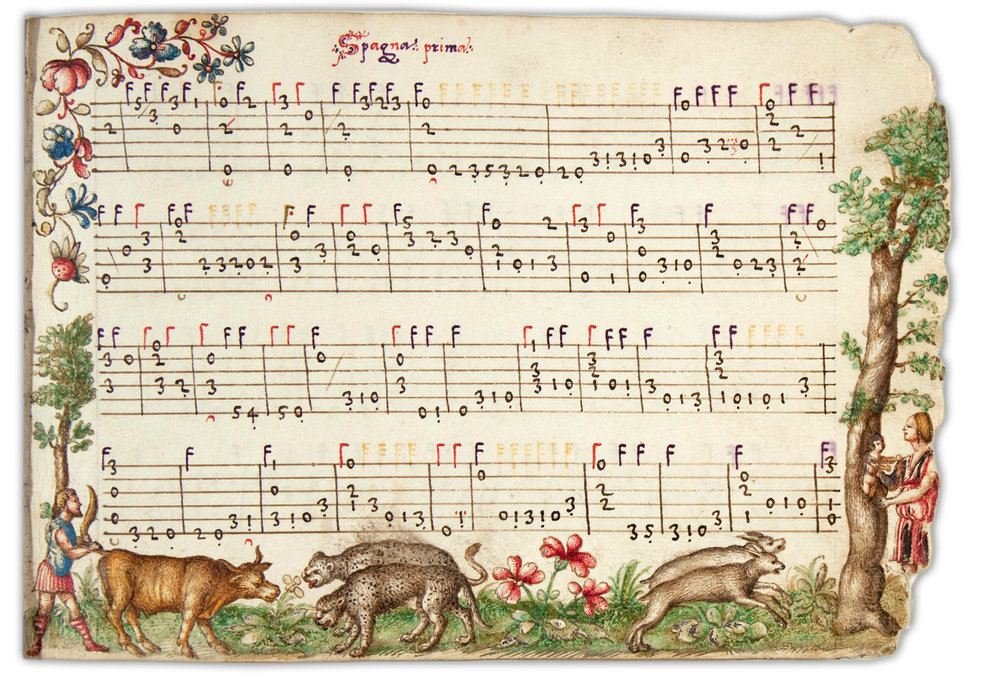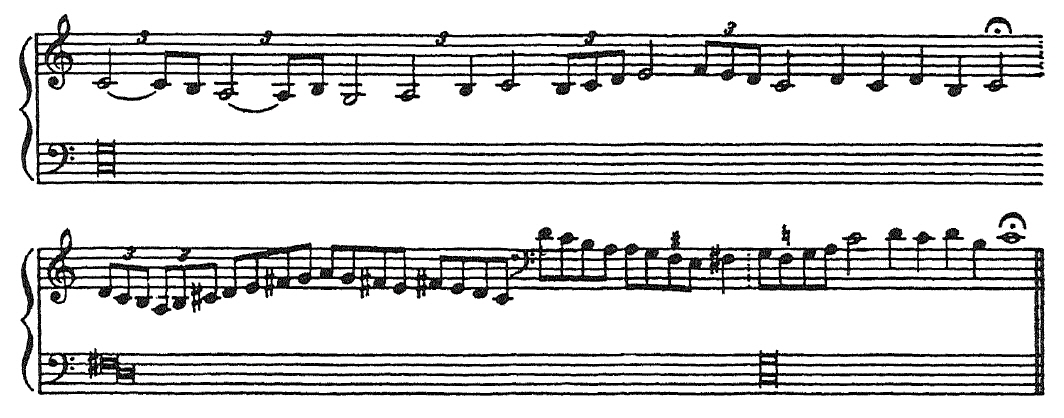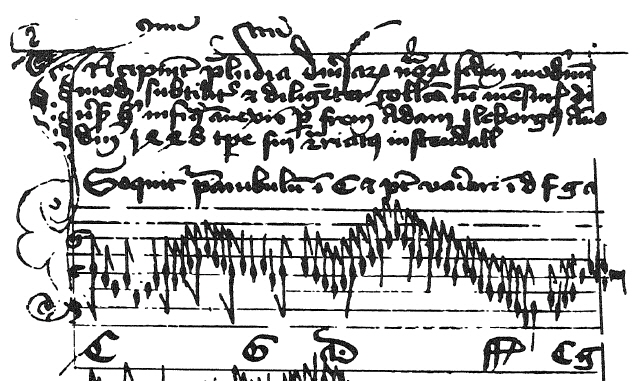Tablature of Adam Ileborgh (1448)
Philadelphia, Curtis Institute of Music
Upon first inspection, it is in Early German Tablature, left hand indicated with letters (starting with C, G, D, etc.) and the right hand in notes on a single staff. The Latin inscription reads, “Here begin preludes in various keys according to the modern manner (in modern style?), cleverly and diligently collected, with diverse mensurae appended hereinbelow, by brother Adam Illeborgh, in the year of our Lord 1448, during the time of his rectorate in Stendall.”1 Above the first staff reads: “There follows a preamble in C which may be transposed into the keys of d, f, g, a.”2 So the first staff is a preamble in C:
Preamble in C
a transcription of Adam Ileborgh Tabalture (1448) by Wili Apel (1942)
Of course, this is modern-player-friendly, but completely takes away the notation for the horizontal pedal feel which is unique to this preamble as most of the other pieces in this collection are notated on one staff only without letters.3 Modern transcriptions could be helpful, but as Parrish states, most often they could so easily turn into personal interpretations and compromises.
Besides a healthy independence from someone else’s work, “An understanding of the evolution of notation can often aid in forming a reasonable presumption on which to work, pending a final solution.”4 A closer look at the notation is just another method of achieving a more informed, more authentic performance practice. In addition, a full understanding of music notation also depends on a thorough familiarity with the notation from the previous era understanding how the music notation of a work came about from the previous system. This renders a deeper, clearer understanding of any work of music.
Perhaps at this point I should mention a few disadvantages of tablature notation. The most obvious one is that it does not show any melodic or intervallic contour at a first glance. Williams judges this to be impractical for violinists and winds (each instrument will need a different system that fits best which will not be universal for all instruments) and points out that it is also not ideal to express distant modulations5 which is, of course, very prominent in the music of later periods. However, he suggests that solfege could have been a type of revived tablature in the 19th century.6
The very first advantage I experienced when I was training in tablature to perform was its clear display of polyphony which was very much needed for the solo performer of polyphonic music in the 16th century, whereas the display of voices onto 2-staff, 2-hand score will really mash up the contrapuntal lines into the staves. This also makes the tablature notation versatile. It would be possible to put it on a table for 4 players to play, whereas this would be much harder to accomplish with a 2-staff keyboard score. In addition, what I have experienced in my interactions with the experiment participants (especially the ones without advanced keyboard skills) is that tablature is a fantastic pedagogical tool. Just as the tablature treatises say, it is beginner-friendly. As music performers, we seldom realize how much information the staff notation contains. My experience as a piano teacher for more than 12 years working with children has really enlightened me about the difficulties of getting fluent in staff notation for beginners and young children. Most children’s method books do not even start out with staff notation but with finger numbers (just like the Spanish tablature) and with letter names (German). Only after weeks of training with letter names and counting out loud are young pupils introduced to the staff notation. Ife and Trudy attribute the inclusion of Cabezón’s pieces in Venegas’ Libro de cifra to a sales strategy: “relatively easy pieces by a famous composer would appeal to the amateur market and help to promote sales.”7 This is not just a business trick, but I think also an inspirational pedagogical method. Why have students play rigid, unmusical exercises on the harpsichord when they could play easy, beginner-level pieces from a master, such as the “Ave Maris Stella” by Cabezón, which nearly all of my experiment participants could sight-read 20-30 minutes into the module!
Chapter 6
The Advantages and Benefits of Tablature
Even though it may come across as quite intimidating at a first glance, tablature reading is immensely beneficial to any historical keyboardist or a scholar or performer of early music. First and foremost, the most obvious benefit is “the added dimension it gives to the understanding of and feeling for the music” in its original form. In the case of handwritten manuscripts especially, Parrish suggests that they “often suggest through their graphic designs something of the character of the music itself that cannot possibly be transmitted by a transcription in modern notation,” and concludes, “the study of the manuscripts leads to knowledgeable performance.”8 I cannot agree more with this statement. Especially “the undeniable aesthetic pleasure offered by the manuscripts themselves” is enough inspiration to deepen one’s study in performance practice. Parrish continues that the manuscripts are “the products of great skill and craftsmanship, and are sometimes very beautifully illuminated;9 they are truly representative of the artistic sensibilities of the age in which they originated.”10
tablature from the Capirola Lutebook (1520)
Ricerchar secondo (top) and Spagna prima (bottom) by Vincenzo Capirola (1474-1548)
Another very practical benefit is that a “knowledge of notation also gives the study of early music an independence from others who have transcribed it, perhaps incorrectly with lack of understanding. It is unhappily not rare to see transcriptions published today which betray an ignorance of certain fundamental principles of early notation.”11 This point is perhaps the most practical and valuable to today’s historical keyboard player. In my experiment sessions with harpsichordist colleagues, my concluding remark always was that they are now fully able to decipher any tablature in the style they were trained through the modules, which, if I think about it, is astounding. Within just 40-50 minutes of training, all keyboardist participants were able to play 2-part counterpoint pieces and a 4-voice Fabordones from Obras de Musica and a 4-part toccattina by Andrea Gabrieli from the Bernhard Schmid II Tabulaturbuch. These are not just harpsichordists, but modern organists, pianists, other instrumentalists and singers who already had advanced keyboard skills. All original sources I used in my modules are in public domain and not yet completely transcribed and published in modern notation. I informed my colleagues that now they are able to access these themselves, select a piece, and simply play it. The ability to read from tablature, or any original notation, gives us a healthy independence from modern transcriptions. Even if one decides to perform from modern editions, I believe the difference between just blindly studying from someone else’s transcription and possessing the knowledge and the ability to look things up from the original by oneself is immense. It is such a valuable and powerful study tool—and to be gained from just two 50-minute training modules! With this ability, one is not limited to only the repertoire that has been transcribed and published but is able to dive into the wealth of numerous, public-domain-available, untranscribed original keyboard repertoire in tablature for study or even for a premiere performance or recording. The ability to read original notation is a direct tool to (re)discover and uncover obscure, unperformed repertoire and should be very much valued in the current Historically Informed Performance Practice. Parrish continues to stress this importance as well: “The study of notation will also reveal the fact that there remain problems in every aspect of early music that are yet unsolved (some perhaps unsolvable), so that in many cases a transcription is merely a personal interpretation, and other interpretations may also be possible, at least in the light of our present knowledge.”12 As an example of how a modern transcription will lose the feel of the original, following is the first page from the Adam Ileborgh Tablature (1448):
In conclusion, the words of Corrêa de Araujo, an advocate and defender of the tablature system, emphasize its wonderful pedagogical merits in his Prologue in “Praise of the Tablature” from Facultad organica: “the music of this book is notated so easily and altogether so perfectly that there is no better system […] wherever it has been used it has produced marvelous effects, causing young beginners to achieve in a brief time what in previous time could not be achieved after many years of study.”13 I cannot agree more with this statement. Even my non-musician participants who have never learned to read music or have played any instrument before could play a bit of the 2-voice “Ave Maris Stella” by Cabezón after having spent about 45 minutes training in the Spanish tablature module. This is indeed a marvelous pedagogical effect. With the recorded results of the experiment (see Appendix A), truly the pedagogical benefits of the tablature system can no longer be denied. In closing, here are the words of Corrêa defending the tablature system:
Although there are many who do not think well of the tablature, we have obtained these advantages and many others from it and so have the students. […] May the well-intentioned, to whom alone I address everything contained therein, always keep in mind the tablature and my book to the shame and confusion of the venomous critics.14
Somehow I could personally connect with Corrêa ‘s defense of the tablature as I have also been confronted with disapproval from some “critics” at the beginning stages of this research. Joscelyn Godwin in his “Playing from Original Notation,” criticizes the attitude of some (historically informed practice) performers who do not take playing from original notation seriously: “in spite of the contributions of musicologists and instrument makers, who have gone far towards restoring the sounds of the past, today’s performer will still have his eyes firmly fixed on the present, if he is playing or singing from a modern edition. The point is not so trivial as it may seem. Just as hand-writing reveals character, so typography reflects its Zeitgeist.”15 This is a statement published in Early Music in 1974, yet I feel as though it can still speak to early music performers today. Godwin will even go as far as prioritizing the “right” notation over the “right” instrument and states, “I have nothing against (most) modern editions but I would not hesitate to say that a mere pianist who can play from the original score of Parthenia Inviolata, for example, has penetrated further into the Jacobean musical world than someone who plays from a transcription on a Ruckers-type virginal, with the proper bass viol accompaniment.”16 This is a bold comparison that I may not fully agree with, but I do see his point and find it thought-provoking. Not only a novel, modern notation in its day—but also clearly a notation with many merits endorsed by many 16th-century composers, pedagogues, and publishers, tablature speaks to us as an attention-worthy topic for further exploration. Both historical and practical evidence proves that the knowledge of tablature could be an invaluable tool to the historical keyboardist today.
Preamble in C
Tablature of Adam Ileborgh (1448)
What one realizes after further study and deciphering of the entire collection is that the letter notes C and G are not to be played consecutively but to be played C, by the left foot, and G, by the right foot on the pedals, simultaneously. A modern transcription will look like this:17






